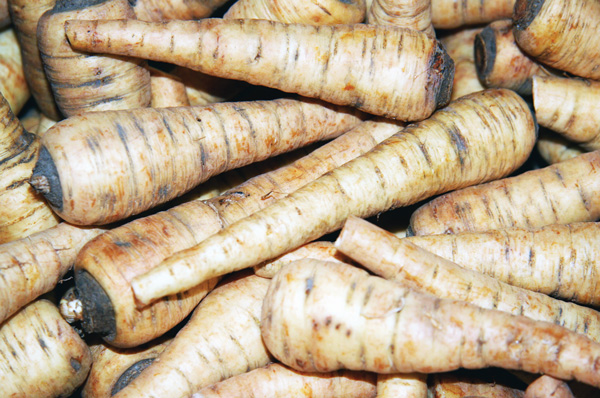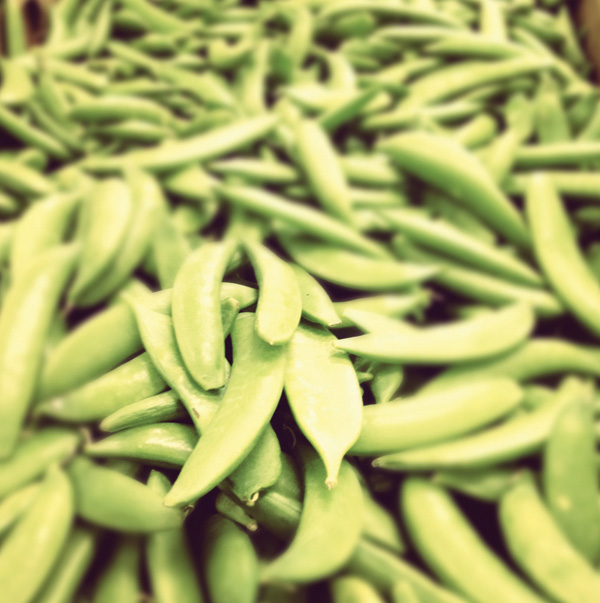Chef Nathan Berg's 5 Farmers Market Favorites

There are hundreds of thousands of chefs in the world, almost all of whom work incredibly hard at their craft with varying levels of success. But for the upper echelon of chefs — the very best of the best — you’ll find that they all have one trait in common: they are remarkably skilled shoppers.
Seriously, although so many whitecoats like to tout their recipes and their creative spirit and their hard work as the reasons for their achievement, the best chefs in all of the world know — and freely admit — that the majority of the skill and hard work that goes into making amazing, mind-blowing food is performed by someone other than themselves. Those someones are the producers: the cheesemakers, the brewers and vintners, the ranchers, the bakers and, mostly, the farmers.
For any chef worth his salt, sourcing the absolute highest-quality ingredients is the single most important skill in creating beautiful dishes, and that is just as true for any great home cook as well. When you start with fantastic ingredients, your job is no longer to use some borderline-magical alchemy scratched on a 3x5 card to concoct delicacies seemingly from thin air; your job becomes “just don’t screw them up”!
As a local-obsessed chef, I’ve spent countless hours at farmer’s markets all over the Midwest scouring for ingredients to bring back to the kitchen. It feels like no matter how many times I go, I find something new and exciting that provides a burst of culinary possibilities. But having cooked through the Wisconsin seasons for nearly a couple of decades now, there are always certain seasonal fruits and vegetables that I have come to look for a certain times of the year. The following is a list of some of my absolute favorites that you might find between now and the end of the market season, along with some notes as to why.
A quick note: This list is a bit personal. I haven’t included many of my utmost favorites because A) you likely don’t need me to explain to you why heirloom tomatoes, fresh herbs, green/yellow beans, and peppers are fantastic and B) I grow all of those things myself and don’t often look for them at the market, unless I stumble upon specific varieties that I don’t have in my own garden.
 1. Crabapples
1. Crabapples
Growing up, our family had a stunning crabapple tree in our backyard which would bloom half-and-half in the spring. By that, I mean that one half of the tree’s flowers would bloom white and the other half pink. Don’t ask me how or why – that’s a question better posed to a botanist than a chef. My mother and I loved the tree for that remarkable spring bloom but my dad hated it because the other 350-odd days of the year, the tree was kind of a pain in the butt. Admittedly, crabapple trees are pretty gnarly-looking when not covered in flowers, all twisted and knotted and twiggy. In the fall, the crabapples would fall all over the place and rot, making the mowing of the backyard more like an amateur juice pressing. They were also big enough to hurt when you stepped on one wrong. Eventually, after my parents divorced and I was about to move out on my own, my dad had free reign to cut it down.
It wasn’t until much later in life that I learned about using crabapples for cooking. Had I known way back then all the amazing culinary capabilities of the crabapple, I’m sure I could’ve gotten my father to make an earlier peace with this tree, possibly even saving its life.
Crabapple trees are all over the place here on our slice of the planet, and many folks have them growing on their property for their eye-pleasing spring display. But strangely, very few people know or care that the fruits of these trees are edible, much less how to cook with them.
Sure, as the name would suggest, most crabapples are far too abrasive to eat straight off the tree although a few varieties, such as the Chestnut Crab, exist to be the exception. Chestnuts are quite a bit larger than the average crabapple and also far sweeter. Almost all of the other “ornamental” varieties are incredibly sour, almost to the point of bitterness. But in a state that grows and consumes as many cranberries as Wisconsin, I think we should have a pretty natural instinct of what to do in the kitchen with a fruit that’s far too sour to eat plain.
Sweetness! Yup, making crabapples pleasant generally takes a decent amount of sugar, honey or other form of sweetener. The most common form of using crabapples is to make jelly which, if you use one of the bright-red varieties, yields what might be the most beautiful jelly in all the world. It comes with a marvelous deep pink color and sweet-tart flavor that can hold it’s own as well on a plate of $20/pound cheeses as it can with peanut butter between two slices of bread. In the same fashion, you can also use crabapples to make a more tart and bright version of apple butter or even applesauce!
But years ago, I began to discover the glory of using crabapples in other manners, too. Combined with stock, shallots and fresh herbs, crabapples can be reduced to create a tart sauce that proves an excellent partner with beef, lamb, venison, elk and bison. Crabapples can be juiced and that juice can serve as a substitute to both vinegar and verjus, albeit with local flair. I’ve even used crabapples to create a sourdough starter that I used for a few years named “Crabby Patty.” Truthfully, the culinary applications for crabapples have not been explored near enough, so if you’re feeling adventurous, just buy or pick some and start your own experiments.
There are no varieties of crabapple that are inedible so if you see them at a farmer’s market, you can be confident in what you’re buying. Ask some questions of the grower themselves; what do they taste like, how would they use them, etc? Of the varieties that I know by name, Dolgo are an excellent red form of the standard (super-sour) crabapple, while both Chestnut and Whitney crabs are both great examples of the slightly-sweeter version.
 2. Corn
2. Corn
I absolutely love corn, and its appearance at the market in the latter half of summer is one of those welcome annual benchmarks. Corn gets a bit of a bad rap these days – due in no small part to Michael Pollan’s exposé on its excessive prevalence in processed foods in The Omnivore’s Dilemma – so I sometimes think that thoughtful eaters have begun to forget that fresh corn is both unprocessed and freakishly delicious. Corn is native to our hemisphere and entire ethnic populations have survived for centuries relying upon it for a significant percentage of their sustenance, so I can see no reason that simple, fresh preparations of non-GMO corn should be anything but celebrated and enjoyed.
Please note that I have yet to use the term “sweet corn” even though that’s essentially what I’m referring to. One of the greatest vegetal disappointments of my lifetime has been the bastardization of corn by American breeders who seem to be in a race to pump ever more sugar onto the cob. Sweet. Super-sweet. Ultra-sweet. Über sweet. Corn has an inherent sweetness which is largely responsible for its mass appeal, but it is still (or at least should be) considered a savory vegetable.
So when you’re looking for corn at the market, try to find varieties that don’t have additional adjectives in front of the word “sweet.” The best ears should feel firm and have non-slimy silk at the top. Nature begins converting corn’s natural sugars into starch the moment it’s plucked from the stalk, so always try to buy corn that’s had the shortest adventure from field to market. Likewise, only buy as much sweet corn as you’ll use in one serving and make that serving happen as soon after purchase as possible.
Lastly, don’t be afraid to experiment with corn in ways that you have never considered. Cultures far south of us have a long tradition of flavoring corn with a combination of chili pepper and limes; if you’ve never tried this, do your best to fill that void this summer. Cut the kernels from the cob and roast or saute them, adding them to salads or burgers or anything really. I’ve even made a good deal of sweet corn ice cream in my day and that’s always been a hit. If that doesn’t prove corn’s versatility, what will?
 3. Parsnips
3. Parsnips
I’m not really in the business of ranking my love for ingredients, but if I were to create a list of my favorite vegetables, parsnips would be right near the top. I’m not entirely sure why, but I feel like parsnips are one of the most overlooked vegetables in the Upper Midwest. They thrive in northern climates such as ours, they are one of the easiest to store long into the cold winter, and their flavor has a sweet vanilla-like warmth. You’d think they’d be a staple in every kitchen from November to March. Alas, they are not.
But maybe it’s just because folks aren’t sure what to do with them. Let’s work on that. First of all, short of cutting them into sticks and eating them raw, you can use parsnips in almost any way that you would use carrots. In fact, if you want one the quickest and easiest examples of how incredible the flavor of parsnips is, make a carrot cake substituting their white cousins. You might never make this cake with carrots again! Roasted, mashed, boiled, sautéed ... there’s really no way to go wrong with parsnips.
But one of greatest culinary secrets in the world is how amazingly well parsnips pair with lobster. If you’re a fan of this coastal crustacean, you simply must grab some parsnips, a half-pound of butter and a bottle of non-trashy chardonnay and devise a plan to consume all four in the same sitting. Heaven.
 4. Cherries
4. Cherries
Everyone loves cherries, right? And here in Wisconsin, we all certainly seem to clamor for those “Door County cherries.” Door County does have a particular lake-effect-induced microclimate that affords them the luxury of a bountiful crop of high-quality cherries, but let’s not forget that cherries can (and do) grow on our side of the state as well. They’re definitely a little harder to find at the markets in our area because no one has yet been bold enough to grow them in significant quantities – they are a pretty big gamble in terms of year-to-year production – but they’re out there. And when you see them, be sure to snatch them up.
“They’re definitely a little harder to find at the markets in our area because no one has yet been bold enough to grow them in significant quantities — they are a pretty big gamble in terms of year-to-year production — but they’re out there. And when you see them, be sure to snatch them up.”
Sweet cherries that can be eaten as is are almost exclusively the product of destinations west of here, and while a few Door County growers can produce them, almost all cherries in our neck of the woods are the sour varieties. While they aren’t very conducive to eating out of hand, these sour types are still uniquely delectable and useful in a wide variety of fashions. They make for amazing pies (Twin Peaks fans unite!) which is why they’re often referred to as “pie” cherries, but the fun doesn’t stop there. Sour cherries can be juiced, pickled, soaked in booze, and otherwise preserved, the applications of which are limited only by your culinary imagination. Personally, I have fondness for using sour cherries to make vinaigrettes and incorporating them into sauces that accompany meat. But really, with these bright red jewels, the possibilities are endless.
 5. Snap Peas
5. Snap Peas
I’m not sure if there’s a flavor in the Upper Midwest that more clearly defines the middle of summer for me than fresh snap peas. Intensely sweet, but with those grassy green overtones, I just don’t know if my brain could even handle the debilitating confusion that would arise from eating them in any other season. Admittedly, they’re one of the few vegetables that I don’t have a long list of kitchen applications for because there’s little that can be done to improve on the clean flavor of the ripe, raw form. I do enjoy making a snap pea sorbet that’s pretty remarkable, and there’s more than a couple of chilled summer soups that they can be a part of but mostly, I like to wash them in cold water, place them in a large bowl and watch them disappear.

